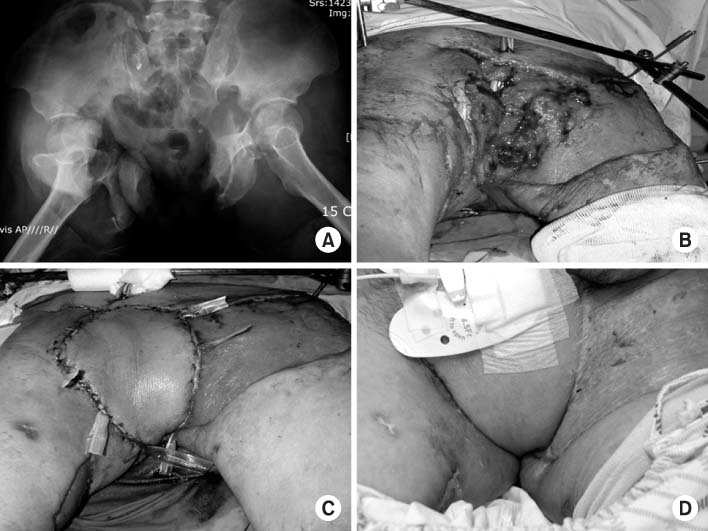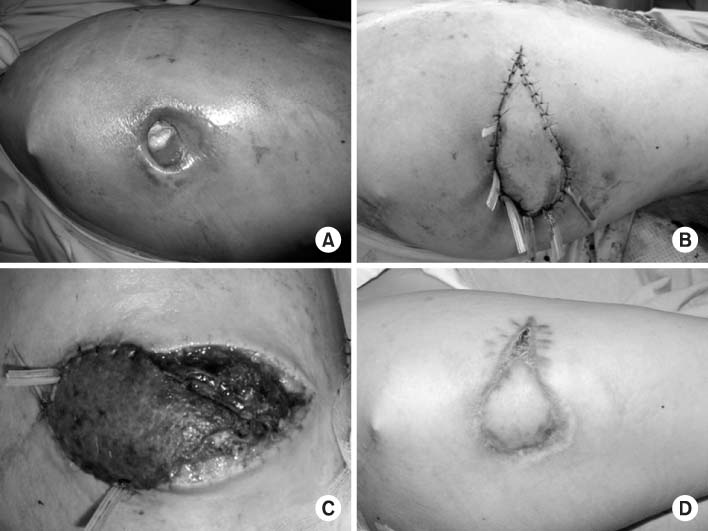J Korean Fract Soc.
2008 Jul;21(3):207-212. 10.12671/jkfs.2008.21.3.207.
Anterolateral Thigh Island Flap
- Affiliations
-
- 1Department of Orthopaedic Surgery, East-West Neo Medical Center, College of Medicine, Kyunghee University, Seoul, Korea. ljhortho@yahoo.co.kr
- KMID: 2015443
- DOI: http://doi.org/10.12671/jkfs.2008.21.3.207
Abstract
-
PURPOSE: To present the author's experience using the anterolateral thigh island flap for reconstruction of soft tissue defects around the hip and perineum.
MATERIALS AND METHODS
Proximal based anterolateral thigh island flaps were performed to reconstruct the soft tissue defects at the perineum (3 patients) and the greater trochanter of the hip (one patient) in 4 patients. All patients were male. Mean age was 43 years (range, 32 to 50 years) and mean follow-up was 8 months (range, 6 to 13 months). The causes of the defects were traffic accident in 2 cases, necrotizing fasciitis 1 case, and pressure sore 1 case. Average size of the flap was 14x9 cm. Fasciocutaneous flaps were performed in 3 patients and musculocutaneous flap was performed in one patient.
RESULTS
All flaps were survived. There were no necrosis of the flaps. One flap presented venous congestion after surgery, which resolved with the decompression of the pedicle. Reconstruction with the anterolateral thigh island flap resulted in no recurrence of the infection or ulcer and good esthetic contour.
CONCLUSION
The anterolateral thigh island flap is a reliable flap for reconstruction around the perineum and hip joint.
MeSH Terms
Figure
Reference
-
1. Burke TW, Morris M, Roh MS, Levenback C, Gershenson DM. Perineal reconstruction using single gracilis myocutaneous flaps. Gynecol Oncol. 1995; 57:221–225.
Article2. Chen CY, Hsieh CH, Kuo YR, Jeng SF. An anterolateral thigh perforator flap from the ipsilateral thigh for soft-tissue reconstruction around the knee. Plast Reconstr Surg. 2007; 120:470–473.
Article3. Gravivanis AI, Tsoutsos DA, Karakitsos D, et al. Application of the pedicled anterolateral thigh flap to defects from the pelvis to the knee. Microsurgery. 2006; 26:432–438.
Article4. Hallock GG. The proximal pedicled anterolateral thigh flap for lower limb coverage. Ann Plast Surg. 2005; 55:466–469.
Article5. Hsieh CH, Huang KF, Jeng SF, Tsai HH, Yang JC, Chiang YC. Reconstruction of open pelvic fracture skin defect with an anterolateral thigh island flap: a case report. J Trauma. 2007; 62:1277–1280.
Article6. Jain AK, DeFranzo AJ, Marks MW, Loggie BW, Lentz S. Reconstruction of pelvic exenterative wounds with transpelvic rectus abdominis flaps: a case series. Ann Plast Surg. 1997; 38:115–122.7. Kimata Y, Uchiyama K, Sekido M, et al. Anterolateral thigh flap for abdominal wall reconstruction. Plast Reconstr Surg. 1999; 103:1191–1197.
Article8. Lee JT, Cheng LF, Lin CM, Wang CH, Huang CC, Chien SH. A new technique of transferring island pedicled anterolateral thigh and vastus lateralis myocutaneous flaps for reconstruction of recurrent ischial pressure sores. J Plast Reconstr Aesthet Surg. 2007; 60:1060–1066.
Article9. Luo S, Raffoul W, Piaget F, Egloff DV. Anterolateral thigh fasciocutaneous flap in the difficult perineogenital reconstruction. Plast Reconst Surg. 2000; 105:171–173.
Article10. Pan SC, Yu JC, Shieh SJ, Lee JW, Huang BM, Chiu HY. Distally based anterolateral thigh flap: an anatomic and clinical study. Plast Reconstr Surg. 2004; 114:1768–1775.
Article11. Song YG, Chen GZ, Song YL. The free thigh flap: a new free flap concept based on the septocutaneous artery. Br J Plast Surg. 1984; 37:149–159.
Article12. Yildirim S, Avci G, Akan M, Misirlioğlu A, Akoz T. Anterolateral thigh flap in the treatment of postburn flexion contractures of the knee. Plast Reconstr Surg. 2003; 111:1630–1637.
Article13. Yu P, Sanger JR, Matloub HS, Gosain A, Larson D. Anterolateral thigh fasciocutaneous island flaps in perineoscrotal recosntruction. Plast Reconstr Surg. 2002; 109:610–616.
Article14. Zhou G, Zhang QX, Chen GY. The earlier clinic experience of the reverse-flow anterolateral thigh island flap. Br J Plast Surg. 2005; 58:160–164.
Article
- Full Text Links
- Actions
-
Cited
- CITED
-
- Close
- Share
- Similar articles
-
- Anatomical Characteristics and Versatility of the Anterolateral Thigh Flap
- Total Tongue Reconstruction with Folded Anterolateral Thigh Free Flap
- Reconstruction of the Tissue Defects of Extremities with Anterolateral Thigh Free Flap
- Reconstruction of Disarticulated Knee Stump by Using Distally Based Anterolateral Thigh Island Flap
- Reconstruction of the Digit Using Anterolateral Thigh Perforator Flap




